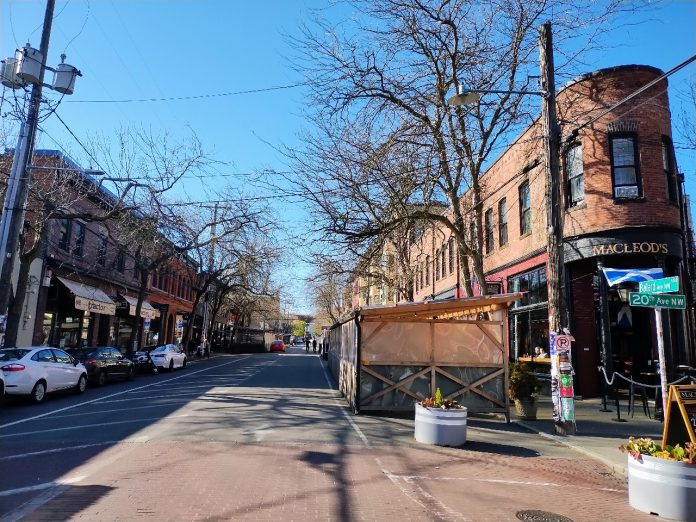
This week, the Seattle City Council will discuss potential amendments to the eight-year transportation levy that will be sent to voters this November, replacing the expiring 2015 Levy to Move Seattle. The amendments seek to steer the levy toward individual councilmembers’ priorities, adding individual projects within their districts or broadly reallocating funding away from other programs.
Council transportation committee chair Rob Saka had already introduced a “chair’s amendment” that is intended to reflect the values and priorities of the entire council, which added an extra $100 million onto Mayor Harrell’s final levy proposal, bringing it up to $1.55 billion, or around $194 million in transportation funding per year. That proposal is now the new baseline, with the majority of that additional funding ($63 million) set to go toward filling in gaps in the city’s missing sidewalk network.
Numerous amendments seek to go after the $20 million that the chair’s amendment added for generic freight-related improvements — a priority of the Seattle Metropolitan Chamber of Commerce — while others seek to take a bite out of the significant increase set to go toward arterial street maintenance. That program is currently poised to receive $350 million and wasn’t touched in Saka’s revised proposal.
Saka amendments include Fauntleroy Boulevard reboot
Separate from the “chair’s amendment,” District 1 Councilmember Rob Saka’s own district-specific amendments are smaller scale and all focus on repaving projects. Without changing the total amount set to go toward road maintenance, Saka proposes expanding the scope of a planned repaving of 35th Avenue SW to encompass the busier parts of that street toward the West Seattle Bridge. Saka’s amendment would add Fauntleroy Boulevard SW onto the repaving project list as well.
A full revamp of Fauntleroy Boulevard, including tree-lined medians and protected bike lanes, had been funded via the 2015 Levy to Move Seattle. However, the City shelved the project and diverted funding after initial proposals for the West Seattle Link light rail extension project hinted that Sound Transit might need to tear up that street within the next decade. The agency’s current preferred alternative mostly bypasses the Fauntleroy corridor itself, but it’s not clear whether Saka’s amendment, which doesn’t include any extra funding, would be enough to get the project back to its prior scope. The language specifically suggests a bare-bones project “to keep roadway functional during light rail station construction,” but the project would need to go through Seattle’s Complete Streets evaluation process.
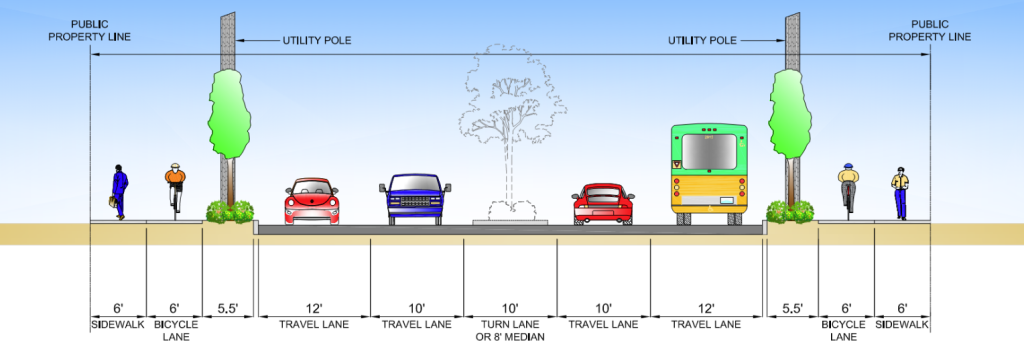
As for 35th Avenue SW, that corridor is set for upgrades including protected bike lanes in the newly approved Seattle Transportation Plan, but that debate will likely be contentious.
With the addition of those two projects, Saka’s amendment removes Corson Avenue S in Georgetown from the list of planned repaving projects. A major truck street, that project had been on the list of freight-focused projects even as this levy included fewer big ticket items for freight interests.
Morales amendments stress bike lanes and station planning
District 2 Councilmember Tammy Morales has introduced a much more wide-ranging amendment. It would add an additional $20 million for new protected bike lanes, an amount that advocates like Cascade Bicycle Club argue will be critical to bridging important gaps in the network over the next decade, after the initial proposal only included around 10 miles of new bike facilities. That $20 million would come from the proposed additions to the freight program, supported by business groups.
It would also reduce the planned repaving budget by $15 million, to fund “community-based planning and improvements” around the planned Graham Street and Chinatown-International District light rail stations within her district. Graham Street is set to open in 2031, and community groups are calling for investments to prevent displacement, funding which could be used to acquire land for affordable housing and community amenities.
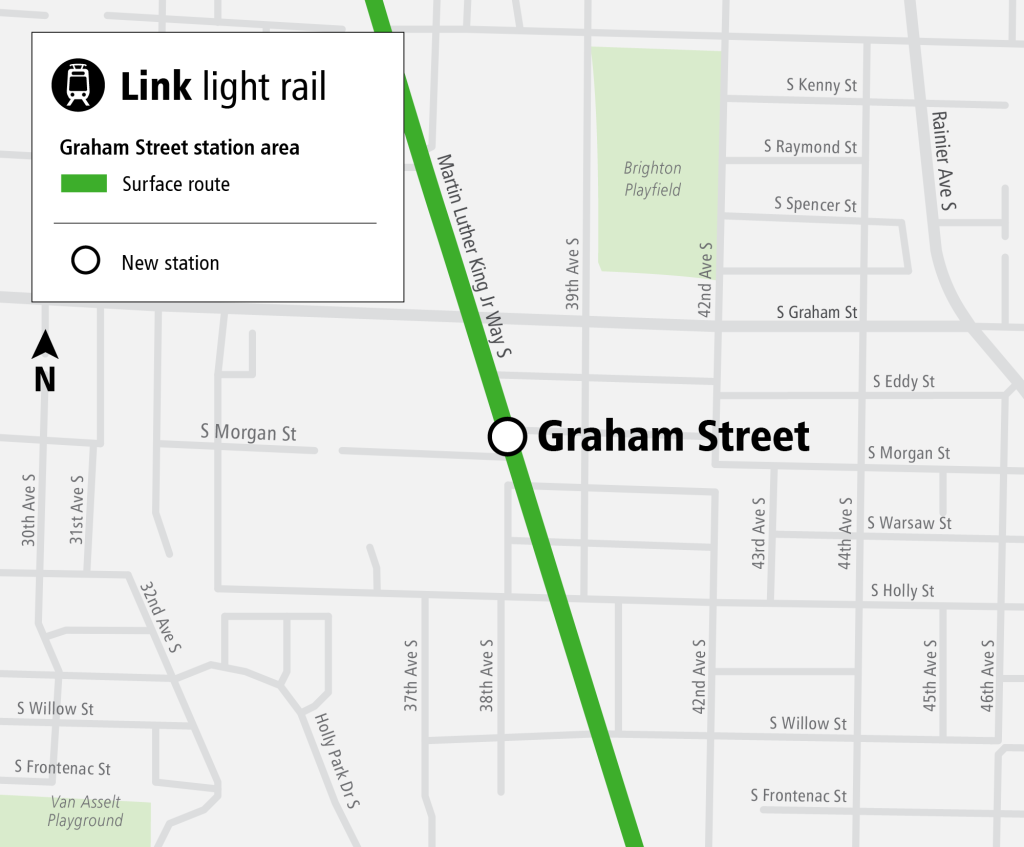
Additionally, Morales restores $15.5 million in funding for a community-submitted street improvement fund, which the Seattle Department of Transportation (SDOT) is calling the “Neighborhood Initiated Safety Partnership Program.” The change would add back $14 million in funding that Saka’s chair amendment stripped, half for the city’s Safe Routes to Schools program and the other half for a new fund that allows district councilmembers to identify their own transportation projects within their districts. New sidewalk funding would see a $1.5 million drop to make that add possible.
Rainier Avenue S would be added to the list of planned Vision Zero investments under Morales’s amendment; the fact that it wasn’t originally included is strange, given the fact that SDOT is planning to repave the corridor at the same time that it invests in transit upgrades as part of its delayed RapidRide R project.
Finally, Morales adds language around the $9 million in investments aimed at safety for transit riders, requiring SDOT to coordinate with both King County Metro and Sound Transit, agencies with their own concurrent safety programs. Transit advocates have raised questions about how new city investments in this area will dovetail with what is already moving forward.
Hollingsworth amendment boosts sidewalk repair
District 3 councilmember Joy Hollingsworth, vice-chair of the transportation committee, has proposed a minor amendment that would shift some of the funding Saka’s amendment proposed for new sidewalk construction toward maintenance of existing sidewalks. That $15 million in shifted funding is said to result in 60 fewer blocks of new sidewalks over the life of the levy — an estimate that may have proven a bit high based on the per-block cost of new sidewalks that the city has seen in recent years, even as the City has shifted to building some blocks with lower cost materials and less substantive drainage improvements.
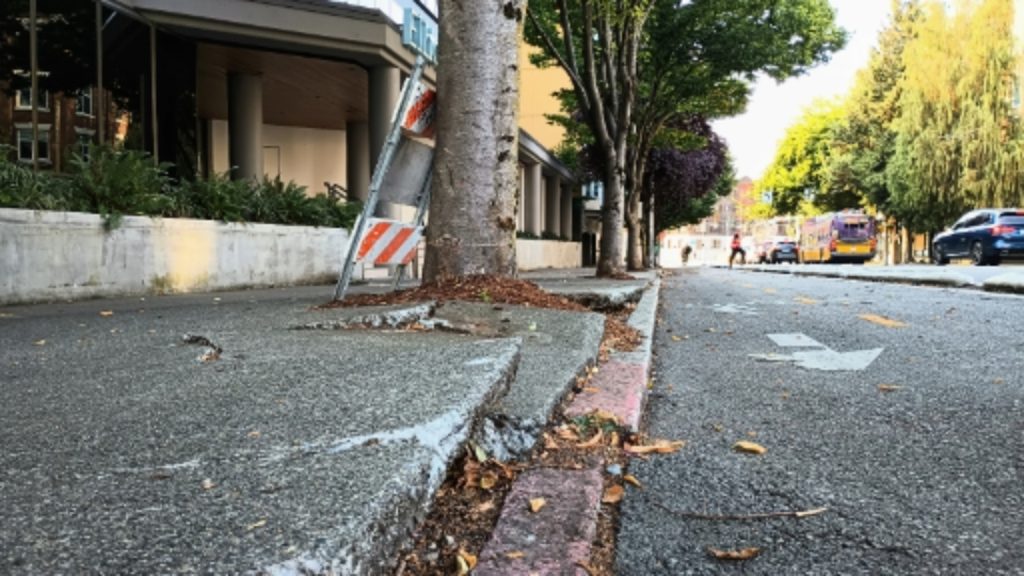
A 2021 audit found that nearly half of Seattle’s existing sidewalks are in such poor condition that they may hinder mobility, which could be an undercount given the prevalence of disjointed pavement and missing curb cuts across the city. Hollingsworth’s amendment is said to reflect “the proportional spending in the Mayor’s proposal between new sidewalks and existing sidewalks.”
Hollingsworth also adds a corridor in her district onto the list of planned protected bike lanes: 12th Avenue between Madison Street and the Jose Rizal Bridge at the north end of Beacon Hill. This is a no-brainer corridor for investment in the next levy, connecting with a new bike lane on the north end of Beacon Hill that’s about to start construction with the brand new RapidRide G corridor. But the amendment doesn’t include any additional funding for this project.
Strauss amendments include curbless designs for Ballard Avenue
District 6 Councilmember Dan Strauss’s amendments include a laundry list of tweaks, mostly to projects in his Northwest Seattle district. At the top of the list is, perhaps unsurprisingly, $20 million to complete Strauss’s vision for the Missing Link of the Burke Gilman Trail, via Leary Way NW and NW Market Street. Routing the regional trail along Leary instead of along Shilshole Avenue NW has been a goal of Strauss’s since his first campaign for council in 2019, and SDOT has been advancing designs within the past year. This $20 million in construction funding would come from the arterial repaving fund.
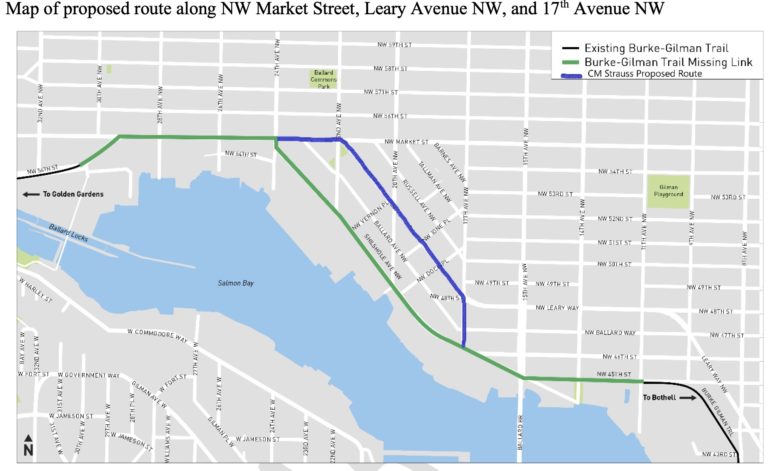
Strauss proposes reallocating $10 million from the generic freight program and instead spending it on a “Leary Way Industrial Zone Safety Improvements” project. Industrial advocates have spent several years fighting a plan to speed up the Route 40 through Leary Way while making pedestrian improvements at the same time, but it’s not clear exactly these funds would do except “implement crossing safety and intersection improvements” along the street.
Strauss also proposes diverting $5 million each from the fund for new sidewalks and from the levy’s vehicle electrification program to fund $10 million worth of upgrades to Ballard Avenue’s cafe street, a District 6 corridor that has already received a significant amount of attention in recent years. The project would apparently make Ballard Avenue into a “curbless street,” a design that SDOT has had some issues implementing successfully, with subpar examples including Denny Way in front of Capitol Hill Station and Roberto Maestas Festival Street in front of Beacon Hill Station.
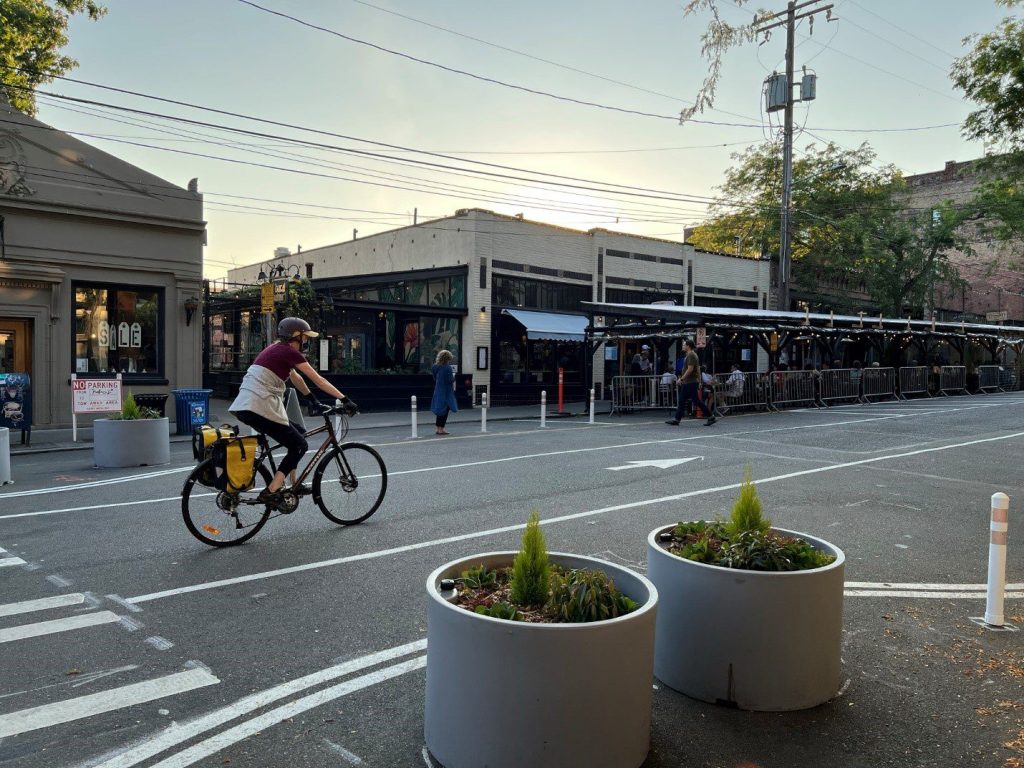
Strauss proposes a $500,000 reduction in protected bike lane funding to advance planning for an I-5 lid in the U District and around the N 130th Street light rail station, work that is set to happen in parallel to planning for a potential I-5 lid in Central Seattle.
While making cuts east of his district, Strauss seeks to add 14th Avenue NW onto the list of planned repaving projects and 6th Avenue NW onto the list of new neighborhood greenways, without adding any specific funding for this.
The amendment expands the planned scope of improvements to the Ballard and Magnolia bridges, adding in potential pedestrian improvements on the Ballard Bridge and work looking at an eventual replacement of the Magnolia Bridge. No additional funding is associated with these changes either.
Nelson amendment emphasizes sidewalk repair
Council President Sara Nelson’s amendment is the only one proposed so far that would decrease the total amount the levy collects over its eight years, and it would only reduce it by just $1 million, by taking out a proposed fund to increase education around potential property tax exemptions that had been added by Saka’s chair’s amendment. That fund appeared aimed at blunting criticism around the size of the levy, which is the biggest in city history, largely due to inflation.
Additionally, Nelson proposes to reduce the fund for district councilmembers’ priorities, instead allocating $7 million to restart the existing Neighborhood Street Fund which had been previously set to be phased out. It’s unclear how this would be different from the Neighborhood Initiated Safety Partnership Program.
Nelson’s amendment would also reallocate $20 million in funding from new sidewalks to sidewalk repair, going a little further than the Hollingsworth amendment would. Finally, it would reallocate $700,000 that had been set to look at long-term funding strategies for sidewalks, bridges, and roads and would instead spend that money on maintenance for the Central Waterfront project.
Moore amendment would defund stairway repair, community-focused project fund
A late-breaking amendment proposed by District 5 Councilmember Cathy Moore dropped late Monday, and it includes a lot of substantial changes. It would eliminate the Neighborhood Initiated Safety Partnership Program entirely, directing most of that funding to the council district project fund.
It would completely eliminate the city’s neighborhood greenway program from the levy, instead directing the $20 million to protected bike lanes, additional bike lane barriers, and “bike spot improvements.” It would also eliminate the funding for stairway maintenance from the levy. The city maintains over 500 public stairways, but the $4 million for that program, along with the entirety of the $9 million set to go to transit rider safety programs, would instead go to Vision Zero projects.
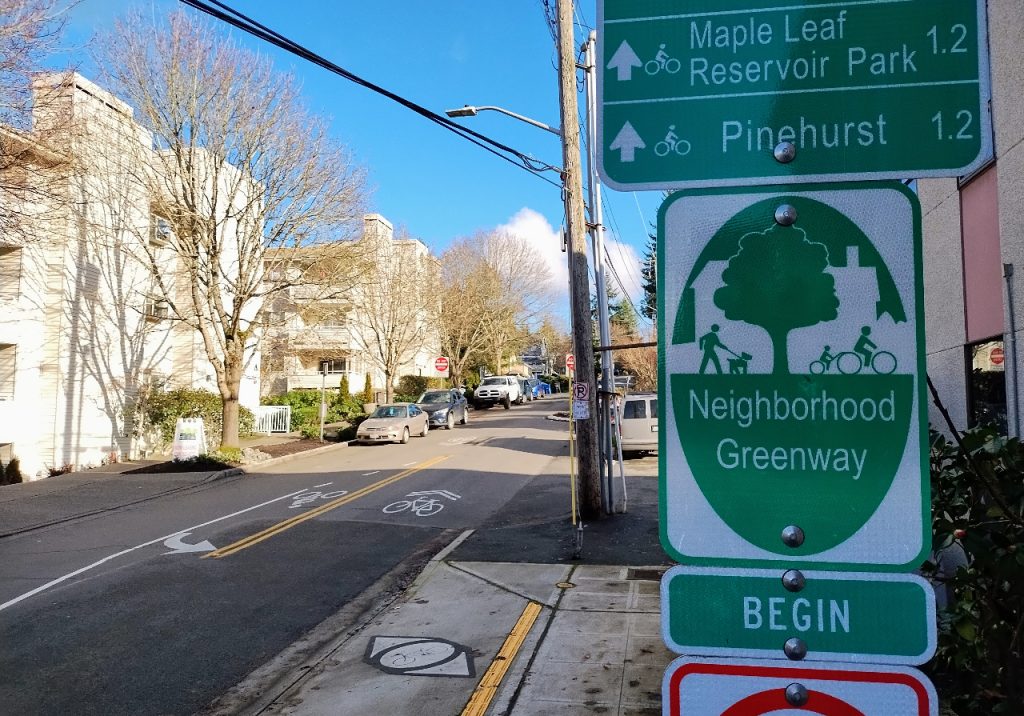
Moore’s amendment also makes a number of changes to the new sidewalk program, without changing any overall dollar amounts. It would set a baseline requirement for which districts new sidewalks would be in, with 36% required to be built in her district. It also adds a requirement that new sidewalks be built within a mile walkshed or a school or a half mile walkshed of a bus that comes at least every half hour. And it adds specific segments of stretches of sidewalks to be built, including the entire “walkshed network” around N 130th Street station.
Looking ahead
The council’s select committee on the levy will be discussing all of these amendments during its Tuesday morning meeting, but they won’t be voting until the July 2 meeting, when the entire package will be voted on. That leaves the door open for potential walk-on amendments, given the fact that nearly half of the council — Councilmembers Maritza Rivera, Cathy Moore, Bob Kettle, and Tanya Woo — haven’t proposed any at all yet. (Update: an amendment from Councilmember Moore’s office was posted late Monday and added above.)
Ryan Packer has been writing for The Urbanist since 2015, and currently reports full-time as Contributing Editor. Their beats are transportation, land use, public space, traffic safety, and obscure community meetings. Packer has also reported for other regional outlets including Capitol Hill Seattle, BikePortland, Seattle Met, and PubliCola. They live in the Capitol Hill neighborhood of Seattle.


